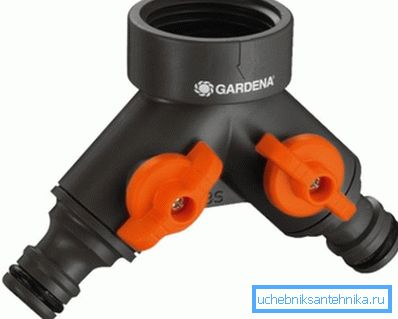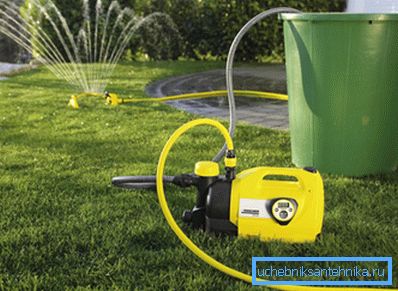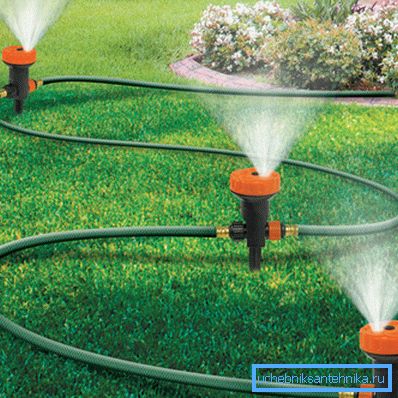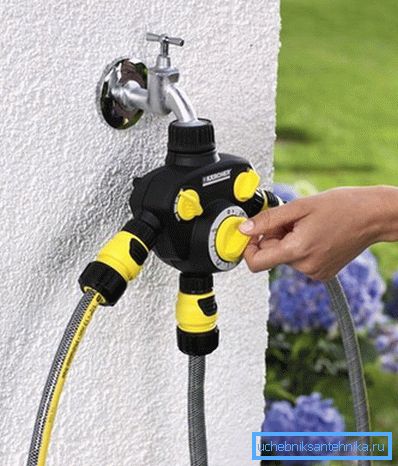How to use the crane for irrigation in the irrigation system
In regions with a temperate and continental climate, with the onset of the warm season, the average monthly amount of natural precipitation decreases significantly, so owners of their own garden and garden plots are forced to use artificial irrigation systems to irrigate grown crops.

Overview of Garden Irrigation Systems
Currently, there are a large number of different systems and mechanisms that allow you to fully or partially automate the process of irrigation of fertile land in the country, in a garden or a vegetable garden. Some of them can work fully in automatic mode, and be guided by the readings of sensors measuring the temperature and humidity of the soil, and also have a timer to turn on the water for a certain time.
Semi-automatic and manual systems also provide significant assistance in watering the garden, but for their work requires constant or periodic human participation. The main advantage of manual and semi-automatic systems is a fairly low price compared to fully automatic ones.

Surface irrigation system
One of the most common and most effective direct or surface irrigation systems is the well-known sprinkler systems that you can assemble yourself, but it’s best to buy finished products in specialized stores.
The principle of operation of such devices is that water from water pipes, through a ball valve under pressure enters special nozzles located at a sufficient height above the ground. When exiting the nozzle, it is sprayed and turns into a fine dispersive water mist, which gradually settles down, evenly moistening the soil, as well as the stems and leaves of plants.

Among the main advantages of using sprinklers for artificial irrigation are the following positive points:
- Exposure to fine water mist promotes uniform moistening not only of the root system, but also of the soil surface of the plants, thus creating an imitation of the real natural conditions of a humid tropical climate.
- With good water flow, the spray radius of the nozzles has a wide coverage area, therefore, this installation allows you to process at one time a sufficiently large territory of the garden plot.
- To automate the operation of an artificial irrigation system, it is enough to set an irrigation timer with a ball valve., which must be connected to the inlet of the sprinkler.
The main disadvantages of the operation of sprinkler installations are sufficiently high water consumption, demolition of water mist in case of strong wind, as well as insufficient soil wetting on clay and heavy soils.

Note! To ensure automatic watering with a sprinkler, a sufficiently high water pressure is required, therefore, its use is allowed only when it is possible to connect to a centralized water supply system, or to a pump of an autonomous water supply source.
Drip irrigation system
Drip irrigation is good for irrigating most garden and garden crops. The principle of the drip irrigation system is that water under low pressure through a faucet for drip irrigation by gravity flows through an extensive pipeline system, which consists of a main collector, and a large number of drip hoses evenly distributed throughout the green areas.
The entire length of each drip hose has small holes or slots through which water drips into the soil, evenly saturating it with moisture for a long time.

To independently assemble such a system at the dacha, you will need a metal or plastic tank for watering with a tap, a set of plastic pipes with a diameter of 16-32 mm, rubber, polyethylene, or PVC hoses, plastic taps for watering, as well as a usual set of household plumbing tools.
- A cumulative barrel with a crane for irrigation is installed on the elevated place of the suburban area, to which the main pipeline of plastic pipes is connected with an internal cross section of at least 32 mm.
- The tees are slammed along the entire length of the pipeline, at a certain distance from each other, in each of which a tap for the drip irrigation tape with a plastic fitting for connecting the hose must also be installed.

- Attach a drip hose to the outlet fitting, and then evenly lay it on the soil between the rows of garden crops, or spread out the rings around the bushes and trunks of garden trees, and plug the end end of each hose, making a bend on it, or installing a special plug.
- Depending on the difference in the suburban area, the length of the drip pipe and the distance from the storage tank, all taps for watering the garden should be adjusted so that the water from each hole comes in small drops at regular intervals.
The process of manual drip irrigation is that in the absence of natural precipitation, after filling the barrel, you need to open the main valve on the hose for irrigation, and make sure that as the barrel is empty, fresh water will flow into it.

Tip! To automate the irrigation process, you need to install a tap timer for drip irrigation in the accumulation tank or irrigation pipeline, which will turn on the water supply after a certain time interval.
Soil irrigation system
Soil irrigation of plants makes it possible to moisten the underlying layers of soil, while the top layer of soil remains dry. This protects it from the formation of a dense dried peel, improves the flow of air to the roots, and also allows more efficient use of water.
The principle of operation of such systems is to supply irrigation water into the soil directly to the zone of location of the root system of garden plants. This is achieved by laying a perforated irrigation pipe in the thickness of the earth at a depth of 200-250 mm.
In order to independently organize a soil irrigation system, a detailed instruction will be presented below, which describes all the steps to perform this simple work:
- Over the entire area of the garden plot, at a distance of 700-800 mm, dig out small trenches with a depth of 250-300 mm.

- To loosen the bottom and side walls of the trenches, and to cover the entire wall with a construction polyethylene film, which is designed to protect against moisture absorption into the soil.
- Pour small, sifted gravel with a thickness of 50-80 mm on top of the polyethylene, which will function as a drainage layer, and protect the aquifer from silting.
- Lay perforated plastic pipes or hoses with a section of 16-32 mm on a gravel pad, and fill it with another layer of gravel of the same thickness from above.
- Before connecting the hose to the tap for irrigation, all perforated pipes must be connected in parallel with each other using plastic tees.
- Lay the geotextile strips on top of the gravel drainage layer, and pour in a fertilized fertile soil layer at least 200 mm thick, onto which garden plants can later be planted.

Tip! To eliminate irregularities and burrs that can lead to water leakage, all cut ends of plastic pipes must be filed with a small notch on the outside and inside.
Conclusion
At first glance, the irrigation system described above for the suburban area may seem complicated and costly to manufacture, but later using them will help save a significant portion of free time and also significantly reduce water consumption when performing summer irrigation work.
More detailed information on irrigation systems can be obtained by watching the video in this article, or by reading similar materials on this subject on our website.